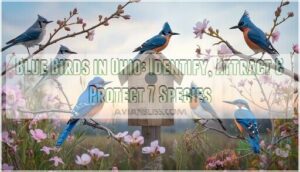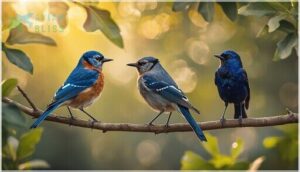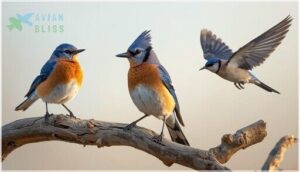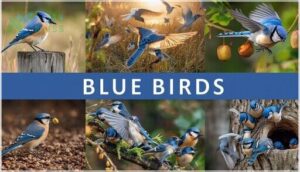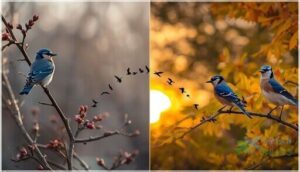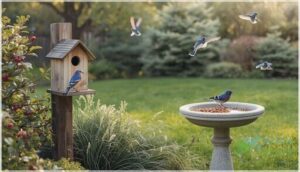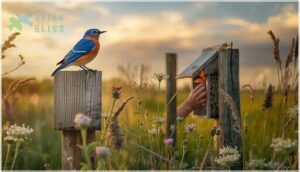This site is supported by our readers. We may earn a commission, at no cost to you, if you purchase through links.
Between 1920 and 1970, Ohio’s Eastern Bluebird population plummeted by 90%, nearly disappearing from backyards and meadows across the state. Thanks to dedicated conservation efforts and thousands of nest boxes, these azure-backed beauties have staged a stunning comeback—and they’re not the only blue birds lighting up Ohio’s skies.
From the electric indigo of bunting males to the bold cobalt of jays in your backyard, seven distinct blue bird species call Ohio home during different seasons. Each species brings its own personality, from the acrobatic tree swallows skimming wetlands to the elusive cerulean warblers hidden in mature forest canopies.
Learning to identify these birds opens up a vibrant world you might be overlooking, and knowing what they need helps you transform your own yard into a haven for these striking feathered neighbors.
Table Of Contents
- Key Takeaways
- Blue Bird Species Found in Ohio
- How to Identify Blue Birds in Ohio
- Attracting Blue Birds to Your Yard
- Blue Bird Habitats and Nesting Habits
- Conservation Status and Protection Efforts
- Frequently Asked Questions (FAQs)
- What birds in Ohio are blue?
- What attracts bluebirds to your yard?
- What do bluebirds in Ohio eat?
- What bird is blue but not a bluebird?
- How can I attract bluebirds to my yard?
- What should I feed bluebirds in Ohio?
- What do bluebird nests look like?
- How can I protect bluebirds from predators?
- Where can I see bluebirds in Ohio?
- What predators threaten blue birds in Ohio?
- Conclusion
Key Takeaways
- Eastern Bluebirds crashed 90% by 1970 but rebounded through strategic nest box programs, proving that targeted habitat interventions can reverse near-extinction—you can replicate this success by installing properly sized boxes (1.5-inch holes, 4-6 feet high) spaced 100 yards apart on predator-baffled poles.
- Seven blue species occupy distinct Ohio niches: cavity-nesters like bluebirds and Tree Swallows claim boxes, Blue Jays build open cups in tree forks, Indigo Buntings hide low in shrubs, and Cerulean Warblers nest 30-60 feet up in mature canopies—knowing these preferences helps you create layered habitat that serves multiple species simultaneously.
- Blue plumage results from light scattering through microscopic keratin structures rather than pigment, and identification hinges on size (6-13 inches), foraging style (perch-and-swoop versus aerial pursuit), vocalizations (soft warbles versus raucous calls), and seasonal presence (year-round residents versus April-September migrants).
- Transforming yards into blue bird havens requires native berry shrubs like elderberry and serviceberry, pesticide-free insect populations (bluebirds consume 66% insects during breeding, shifting to 90% berries in winter), shallow water sources changed every 2-3 days, and open grassy foraging zones—elements that together address nesting, feeding, and hydration needs across all life stages.
Blue Bird Species Found in Ohio
Ohio’s skies and woodlands are home to seven stunning blue bird species, each bringing its own splash of color and character to the state’s diverse ecosystems. From the rusty-chested Eastern Bluebird to the electric Indigo Bunting, you’ll find these birds in habitats ranging from open meadows to mature forests.
Let’s break down each species so you can spot them in the wild and understand what makes them tick.
Eastern Bluebird
The Eastern Bluebird stands out among blue bird species in Ohio with its vivid azure back and rusty-red chest. You’ll spot these year-round residents across open woodlands and suburban areas, where nesting success reached 60% in 2023. Here’s what defines their presence:
- Population trends show stable growth after 90% decline by 1970
- Breeding patterns span late March through September
- Feeding habits shift from insects to berries seasonally
- Bluebird migration patterns vary—some overwinter locally
- Bluebird migration patterns vary—some overwinter locally
- Birdwatching in Ohio reveals their distinctive perch-and-swoop foraging
The Eastern Bluebird’s nesting behavior is influenced by birdhouse or tree selection.
Indigo Bunting
While bluebirds stick close to home, the Indigo Bunting follows a different script—this bird species in Ohio trades brushy fields for tropical winters. You’ll recognize males by their electric blue plumage, though breeding habits reveal strategic nesting 2-10 feet up in shrubs.
Their feeding strategies shift from insects during nesting to seeds year-round. Migration patterns take them across the Gulf of Mexico using stars for navigation, making birdwatching in Ohio particularly rewarding during late April returns.
The Indigo Bunting’s habitat preferences are influenced by bird migration patterns that play a vital role in its survival.
Blue Jay
You’ve probably heard Blue Jays before you’ve spotted them—their raucous calls echo through Ohio’s woodlands year-round. These bold birds measure 9-12 inches, sporting vibrant blue feathers with black and white wing markings.
Blue Jay Migration patterns vary; some stick around all winter while others drift south. Their beak adaptation lets them crack acorns effortlessly, and Jay Social Behavior includes flocking patterns during fall foraging. Watch for their prominent crest signaling mood shifts.
Tree Swallow
Unlike the resident Blue Jays, Tree Swallows are true seasonal visitors—arriving in Ohio wetlands and meadows each March with their iridescent blue-green backs and snow-white bellies. You’ll spot these aerial acrobats catching insects mid-flight, a spectacle central to birdwatching and Bird Conservation.
Tree Swallow Migration patterns make Nest Box Installation essential from April through August, when these Feathered Friends raise their young before departing southward by October.
Cerulean Warbler
You won’t find the Cerulean Warbler without venturing into Ohio’s mature oak-hickory forests—these sky-blue gems inhabit the highest canopy gaps where Forest Ecology and Avian Ecology converge.
Breeding across 11% of the global population, this Species Conservation priority faces steep declines, dropping 70% in recent decades despite Habitat Restoration and Wildlife Preservation efforts focused on Ohio’s southeastern woodlands during Bird Migration season.
Belted Kingfisher
You’ll hear the Belted Kingfisher’s rattling call before spotting this crested hunter patrolling Ohio’s waterways year-round. With glossy blue plumage and a shaggy topknot, this 11-13 inch bird species excavates nest burrows in steep earthen banks near fish-occupied streams.
Despite water pollution and habitat loss threatening their fish diet, Kingfisher Conservation and Wildlife Conservation efforts protect these resilient Blue Birds across Ohio’s rivers and lakes.
Blue Grosbeak
You’ll spot the Blue Grosbeak’s rusty wing bars distinguishing this Ohio newcomer from smaller Indigo Buntings. Adult males flash dark blue plumage with silvery bills, while females wear rusty tan tones.
This bird species has expanded from 11 breeding counties in the 1980s to nearly 70 statewide today. Blue Grosbeak migration spans thousands of miles to Central American wintering grounds, with breeding habits peaking April through August.
How to Identify Blue Birds in Ohio
Spotting blue birds in Ohio starts with knowing what to look for, from color patterns and body shape to the way they move and sound. Each species has its own signature traits that set it apart once you know where to focus your attention.
Here’s what you need to watch for when identifying these stunning birds in the field.
Physical Characteristics and Plumage
Blue bird species in Ohio reveal true color through feather structure rather than blue pigmentation—light scatters through microscopic air pockets in keratin, creating that vivid hue you see.
Eastern Bluebird males show striking blue heads and backs with reddish-brown chests, while female plumage patterns appear more subdued.
Blue Jays display bold blue and white markings, and Indigo Buntings develop an iridescent sheen after their first molt.
Size and Body Shape
When identifying bird species in Ohio, you’ll notice size differences immediately. The Eastern Bluebird measures 6.3–8.3 inches, with a plump thrush build, while the Blue Jay reaches 9–12 inches, boasting sturdy body proportions.
Wing span varies dramatically: Tree Swallows stretch 11.8–13.8 inches for agile flight, whereas Blue Jays span 13–17 inches.
Tail length, beak shape, and feather length reveal essential avian biology details for accurate blue bird species identification.
Behavioral Traits and Foraging Patterns
Watch how each bird species hunts, and you’ll crack the identification code. Foraging Strategies and Social Behavior reveal distinct patterns: the Eastern Bluebird perches on fences before swooping groundward, while Blue Jays methodically weigh and select food items before eating.
- Tree Swallows execute acrobatic mid-air pursuits over wetlands
- Cerulean Warblers glean caterpillars from high canopy foliage
- Indigo Buntings shift between ground seeds and shrub insects
- Blue Jays mob predators aggressively in territorial groups
Vocalizations and Calls
Listen closely, and you’ll discover a world hidden in plain sight. Acoustic signals offer precision when plumage alone falls short. Each bird species broadcasts unique call frequency patterns—unpaired male Eastern Bluebirds belt out hundreds of songs hourly, while Blue Jays cycle through five distinct call types. Indigo Buntings chirp brief, high-pitched notes (110 milliseconds), and Cerulean Warblers string together 0.40-second syllables. The syrinx, controlling tone and pitch through vocal learning, shapes these bird song patterns into nature’s finest identification tool.
| Species | Call Type | Key Feature |
|---|---|---|
| Eastern Bluebird | Soft & loud songs | 309 distinct song types per male |
| Blue Jay | Jeer, pumphandle, rattle | Mimics hawk calls |
| Indigo Bunting | Flight calls | 5.3–9.7 kHz frequency range |
Habitat Preferences
Beyond sound, habitat tells the story—where you look matters as much as what you hear. Blue birds in Ohio reveal themselves through landscape choices shaped by grassland ecology, wetland habitats, and forest edges. Eastern Bluebirds thrive in open fields with scattered trees, often nesting in field borders where 74% of sightings occur. Habitat fragmentation affects every species differently:
- Eastern Bluebird – Grasslands, orchards, parks (30–34 birds per 100 acres)
- Indigo Bunting – Brushy thickets, hedgerows within 50 meters of water
- Blue Jay – Oak-woodlands, suburban areas, forest clearings
- Tree Swallow – Wetlands, ponds, open fields near water sources
- Cerulean Warbler – Mature deciduous forests with open canopy
Seasonal Presence and Migration Timing
Migration patterns influence the presence of certain bird species in northeast Ohio. Eastern Bluebirds arrive by early March and stay until late October, while Indigo Buntings appear in late April and depart for Central America by September. Tree Swallows follow a similar schedule, arriving in late March and leaving by early October.
Blue Jays, however, are year-round residents. Despite their permanent presence, climate effects occasionally trigger irregular movements during the autumn months.
Attracting Blue Birds to Your Yard
Turning your yard into a blue bird haven doesn’t require a degree in ornithology or a massive budget. With a few strategic changes to your outdoor space, you can create an environment that naturally draws in Eastern Bluebirds, Indigo Buntings, and other vibrant species.
Here’s what actually works to bring these birds to your backyard.
Installing Nesting Boxes
Installing nesting boxes transforms your yard into a sanctuary for Eastern Bluebirds and other cavity nesters. Position boxes 4 to 6 feet high, spaced 22 to 25 yards apart, with entrance holes measuring 1½ inches to exclude starlings.
Mount them on smooth metal poles equipped with predator guards—this simple addition can boost nest success rates by 74%, giving your blue birds a fighting chance.
Planting Native Plants and Shrubs
You’ll strengthen wildlife support when you plant native shrubs like viburnum, ninebark, and winterberry holly—these species provide essential habitat and food for bluebirds year-round.
Prepare soil with organic matter to boost ecological balance, then select species that support conservation efforts by hosting insects and offering berries.
Over 140,000 bluebirds have fledged in Ohio thanks to thoughtful garden maintenance incorporating native plant benefits.
Providing Water Sources
You can’t overlook water provision—bluebirds need shallow birdbaths (1-2 inches deep) placed near cover within 10-20 feet to balance accessibility with predator safety.
Change water every 2-3 days to maintain water quality and prevent disease transmission, which drops visitation by 14% when neglected. Moving water attracts 35% more bluebirds, and heated sources boost Ohio’s overwinter survival rates, supporting essential wildlife conservation efforts statewide.
Creating Insect-Friendly Landscaping
You’ll boost bluebird visits by transforming your yard into an insect haven—native plant diversity anchors this ecology, with oaks supporting over 450 lepidopteran species that feed hungry nestlings. Ground cover options like marginal wood fern create year-round insect habitat, while pollinator gardens attract the prey bluebirds need.
- Plant at least 10 flowering native species to increase insect abundance by 80%
- Leave 20% of leaf litter undisturbed for overwintering beneficial insects
- Choose native groundcovers to reduce water use by 50% while supporting wildlife conservation efforts
- Maintain continuous plant cover for 20-35% higher insect populations in your nature sanctuary
Avoiding Pesticides and Herbicides
Chemical sprays poison the very insects your bluebirds need—100% of tested nests harbor pesticide residues that kill offspring and reduce clutch sizes by 20%. Sustainable landscaping with eco-friendly practices eliminates herbicide risks while supporting environmental conservation.
This shift reduces environmental impact and tackles climate change concerns, honoring the ecological importance of healthy bird populations. You’ll protect habitat and conservation by choosing organic gardening and pesticide alternatives instead.
Blue Bird Habitats and Nesting Habits
Understanding where blue birds set up camp and raise their young can help you turn your yard into their next favorite spot. Each species has its own nesting quirks, from the boxes they prefer to the timing of their breeding cycles.
Let’s break down what you need to know about creating the right conditions for Ohio’s blue birds to call your property home.
Preferred Nesting Sites by Species
Each blue species follows its own nesting playbook. Eastern Bluebirds and Tree Swallows are cavity nesters, readily claiming nest boxes you install 5 to 20 feet high near open ground.
Blue Jays weave open cup nests in tree forks, while Indigo Buntings tuck their nests low in dense shrubs.
Cerulean Warblers climb highest, nesting 30 to 60 feet up in mature deciduous canopies, favoring white oaks.
Breeding Season Timeline
Timing varies widely among Ohio’s bird species. Eastern Bluebirds kick off nesting cycles in mid-March, often raising two broods through August with 13–16 day incubation periods and 15–20 day fledging rates. Blue Jays follow similar breeding patterns from mid-March through July, while Indigo Buntings arrive later, nesting late April through July.
Tree Swallows concentrate their mating habits in May, and Cerulean Warblers breed exclusively late May to July in mature forest canopies.
Nesting Materials and Box Specifications
Once bluebirds settle in, they’ll use grasses and pine needles to build nests in your cavity nesters’ boxes. Design matters—you want round entrance holes measuring 1.5 inches, a 4×4 to 5×5-inch floor, and walls thick enough for thermal regulation.
Install nest boxes 4–6 feet high in open areas, spacing them 100 yards apart to avoid territorial squabbles among these spirited cavity nesters.
Diet and Foraging Behaviors
Once you’ve got the boxes up, you’ll watch your bluebirds hunt. Eastern Bluebirds swoop from perches—traveling 16 to 65 feet—to snatch beetles and grasshoppers, getting 66% of their diet from insect consumption during breeding.
Tree Swallows master aerial hunting, catching 2,000 insects daily over wetlands.
Come winter, bluebirds shift to berry eating, with wild fruits composing 90% of their cold-season intake.
Monitoring and Maintaining Nest Boxes
Once you’ve established nesting sites, check boxes every seven to 10 days during breeding season. You’ll record eggs, hatchlings, and parental activity while cleaning between broods to prevent parasite buildup.
Mount boxes on smooth poles with baffles—predator control that works.
Ohio volunteers monitor over 100 boxes each summer, achieving fledging success rates up to 100% through consistent maintenance schedules and strategic box installation.
Conservation Status and Protection Efforts
Blue birds in Ohio face real challenges, from disappearing forests to invasive species competing for their homes. The good news is that people across the state are stepping up to protect these species through habitat restoration, nest box programs, and community science.
Here’s what you need to know about the threats these birds face and how conservation efforts are making a difference.
Population Trends and Threats
You’re witnessing a comeback story decades in the making. Eastern Bluebird populations crashed by 90% between 1920 and 1970, driven by habitat loss, nesting competition from aggressive House Sparrows and European Starlings, and pesticide impact.
Eastern Bluebird populations plummeted 90% by 1970 due to habitat loss, invasive competitors, and pesticides—a collapse decades in the making
Since the 1970s, conservation efforts—particularly nestbox programs—have sparked recovery. Climate change and domestic cat predation remain ongoing threats, but population trends now show stabilization across Ohio, proving targeted bird conservation works.
Habitat Loss and Fragmentation
Fragmentation cuts through Ohio’s landscape like puzzle pieces scattered across a table. You’ll see its effects everywhere—monoculture farmlands replacing mixed habitats, urban sprawl isolating forest patches, and roads severing ecosystem connectivity.
Habitat loss has eliminated 90% of suitable nesting areas since 1920, while fragmentation effects increase nest predation and parasitism.
Conservation strategies now prioritize habitat restoration and preservation, reconnecting corridors through environmental sustainability initiatives and smarter urban planning to protect habitat and migration routes.
Ohio Bluebird Society Initiatives
Since 1987, the Ohio Bluebird Society has championed nest box monitoring across the state, documenting nearly 140,000 Eastern Bluebirds fledged through coordinated conservation efforts.
You’ll find volunteer training programs equipping community engagement through hands-on workshops, while conservation funding aids bird-friendly landscaping and habitat preservation initiatives.
Over 300 active members maintain trails with 200+ nest boxes, proving Ohio’s blue birds thrive when conservation efforts meet grassroots dedication.
Citizen Science and Community Involvement
You can join over 300 citizen science volunteers tracking blue bird populations through Ohio Bluebird Society programs, turning your backyard observations into conservation gold. Community outreach and volunteer training shape effective wildlife conservation through:
- Weekly nest box inspections recording eggs, fledglings, and predator encounters
- Data collection submitted to Cornell’s NestWatch for research analysis
- Educational events engaging youth in hands-on bird conservation efforts
- Trail monitoring eliminating 90% of common nest threats through proactive maintenance
Your contributions directly fuel conservation efforts that brought bluebirds back from near-extinction.
Best Locations for Birdwatching in Ohio
You’ll find Ohio’s blue birds thriving at Magee Marsh, where over 70,000 birders flock each spring to witness 300+ species along 2-mile boardwalks.
Cuyahoga Valley National Park shelters Blue Jays and Cerulean Warblers across 33,000 acres, while Lake Erie Birding Trails connect 80+ prime sites.
Howard Marsh’s restored wetlands and Battelle Darby Creek’s 100+ nest boxes deliver reliable Eastern Bluebird encounters during nature and outdoor activities.
Frequently Asked Questions (FAQs)
What birds in Ohio are blue?
You’ll spot seven blue bird species across Ohio: Eastern Bluebirds, Indigo Buntings, Blue Jays, Tree Swallows, Cerulean Warblers, Belted Kingfishers, and Blue Grosbeaks—each displaying distinct feather coloration and habitat preferences.
What attracts bluebirds to your yard?
Like planting a flag on open ground, you attract bluebirds with properly installed nesting boxes, native berry-producing shrubs, shallow water features, insect-rich lawns, and pesticide-free yard layouts that mimic their preferred habitat.
What do bluebirds in Ohio eat?
You’ll see Eastern Bluebirds shift their dietary habits through Ohio’s seasons—insect intake peaks during breeding with beetles and caterpillars, while fruit sources like dogwood and sumac berries dominate winter foraging habits when invertebrates become scarce.
What bird is blue but not a bluebird?
Ohio’s skies burst with hundreds of vibrant blue species beyond bluebirds. Blue Jays, Indigo Buntings, Tree Swallows, Cerulean Warblers, and Blue Grosbeaks all flash stunning blue plumage across the state’s diverse habitats year-round.
How can I attract bluebirds to my yard?
You’ll draw them in by setting up nest boxes with proper placement, planting native shrubs like elderberry, and offering fresh water features.
Skipping pesticides will boost insect populations, and creating open grassy habitat will support their foraging behaviors.
What should I feed bluebirds in Ohio?
You’ll want to offer live mealworms during breeding season, dried mealworms and sunflower chips in winter, plus native berries like elderberry and serviceberries for year-round nutrition that enhances their insect diets and nesting habits.
What do bluebird nests look like?
Delicate yet sturdy, bluebird nests feature a neat cup shape woven from dry grass, weeds, and twigs, usually found in nesting cavities 2–20 feet high. Females line them with finer grasses and feathers.
How can I protect bluebirds from predators?
Installing a predator guard on nest box poles boosts nest survival rates.
Position boxes 5–6 feet high, space them 100 feet apart, and maintain pole surfaces regularly to deter climbing raccoons and snakes while supporting bluebird conservation.
Where can I see bluebirds in Ohio?
You’ll find Eastern Bluebirds along bluebird trails at Magee Marsh Wildlife Area, Cuyahoga Valley National Park, and Shawnee State Park.
Ohio wetlands and nature reserves offer prime bird watching opportunities, especially during spring migration from mid-April through early May.
What predators threaten blue birds in Ohio?
Like sitting ducks in open fields, blue birds in Ohio face snake predation, raccoon attacks, avian threats from hawks, and invasive house sparrows. Habitat fragmentation worsens exposure to these diverse predators.
Conclusion
Bringing blue birds in Ohio back from the brink proves that small actions—mounting a nest box, planting native berry shrubs, skipping the pesticides—create ripples far beyond your property line.
You’re not just attracting vibrant visitors; you’re stitching together fragmented habitats one yard at a time.
Grab your binoculars, join a nest box trail, or simply watch your feeder. These azure ambassadors need allies, and your backyard might be exactly the refuge they’re searching for.

